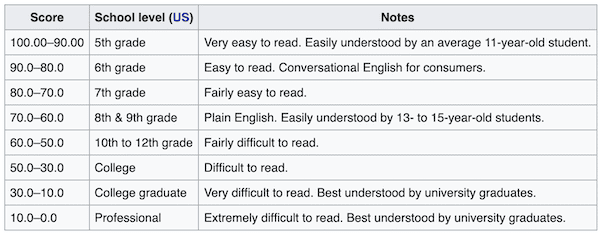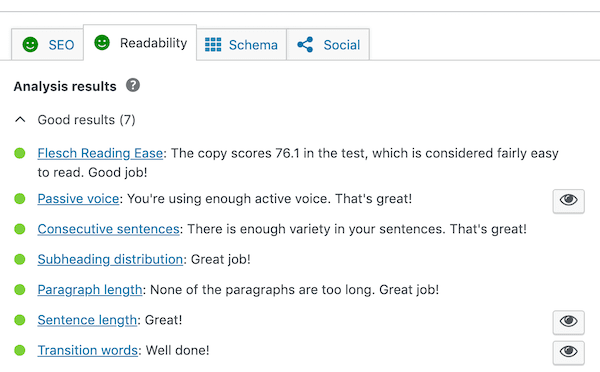When you simplify your writing, you are not dumbing it down. It’s about making your writing clear, to the point, and easy to read.
You can still explain complex ideas, but you need to use language and grammar that people can easily understand.
But simplifying is not as simple as it sounds because it can sometimes be hard work.
You need to know your readers and adapt your writing style to suit them, yet get your message or story across clearly.
Why you should simplify your writing
Simple doesn’t mean dumb or stupid or talking down to your readers.
It means you craft your writing so that people can read it, understand it, or learn from it.
You can still write engaging articles, content, or stories that readers will enjoy reading.
But you have to know your reading audience and adapt your style to suit.
It will be different for a blog post, a technical article, an essay, or an entertaining short story.
You can use readability or writing grade tools to assess the level of your writing.
One of the most popular is the Flesch Reading Ease scale.

It’s a good guide but not a gauge you need to obey.
You are probably not writing for children, so you need to be realistic about the level of your writing.
However, as a general rule of thumb, a score between 60 and 80 is usually suitable for most readers. But how do you change the level of your writing?
10 Ways to simplify your writing
Here are ten simple ways to modify your writing to make it easier to read and understand.
If you take control of these points, you will be on your way to writing more clearly and effectively.
1. Know your point of view
Deciding on your point of view (POV) in any form of writing makes it easier for you to keep your writing consistent and targeted.
You need to think about which voice you want to use and apply it throughout your text.
First-person: I need a haircut.
Second-person: You need a haircut.
Third-person: He needs a haircut.
If you don’t know which voice you are using, you can end up mixing your POV and confusing your readers.
2. Get to the point immediately
When you want to capture readers’ attention, do it in the first sentence.
If you are writing about oxymorons, tell your readers immediately in a simple sentence.
Don’t wait until paragraph four to get to the subject of your text.
You’ll have plenty of time to dig into the nitty-gritty of the topic later in your text.
Good writing is similar to good public speaking.
Tell them what you are going to say (introduction), then say it (body), and finally tell them what you said (summary).
3. Use active voice
Passive voice rarely says anything informative and is highly impersonal.
Passive: The match was canceled because of the weather.
Active: The umpires canceled the match because of the weather.
Always try to use or rewrite in active voice whenever you can because it says who did it.
4. Use short, everyday words
There is nothing worse for a reader than continually consulting a dictionary while reading a text.
It doesn’t mean that you can’t use your vocabulary knowledge. But choose your words carefully with your reader in mind.
Instead of saying polysyllabic words, say long words or big words instead.
Mark Twain said, “don’t use a five-dollar word when a fifty-cent word will do.”
5. Shorten your sentences
Check the length of the sentences in your text.
If you find any with more than twenty-five words, consider rewriting in two sentences.
Another sign of sentences that might be difficult to read is multiple commas. If a sentence uses three or more commas, think about making separate sentences.
6. Short paragraphs
Long paragraphs don’t change the reading level of a text. But they are more difficult to read than shorter paragraphs.
An appropriate paragraph length depends on what you are writing.
For a blog post or article, very short paragraphs are much easier to read on a screen.
But for a short story, a paragraph will contain more sentences.
7. Reduce adjectives and adverbs
If you use adverbs to modify verbs, think about choosing stronger verbs instead.
He ran quickly to the scene of the crime.
He dashed to the scene of the crime.
“I don’t know if I can do it,” she murmured quietly.
“I don’t know if I can do it,” she whispered.
Another way to simplify your writing is to cut down on adjectives that serve little purpose.
When you use more than two adjectives to describe a noun, it’s too many. Look for a more powerful or concise adjective.
It was an exquisite, glorious, golden sunrise that welcomed me to my new home.
It was a beautiful sunrise that welcomed me to my new home.
8. Use the imperative for instructions
When you give instructions in an article, consider using an imperative list instead of a long sentence.
First of all, you need to click on the edit menu, and then from the drop-down list, select Spelling and Grammar and then finally click on Show Spelling and Grammar.
1. Click the edit menu.
2. Select Spelling and Grammar.
3. Click Show Spelling and Grammar.
9. Remove the fluff
There are many phrases and clauses we use in writing that say nothing.
Here are a few examples that are often worth deleting.
As a matter of fact
In the fullness of time
It is interesting to note that
Until such time as
With regard to the topic
All things considered
Also, look for linking phrases that you can replace with one word.
As a consequence of – because
In view of the fact that – because
On the other hand – but
In the event that – if
In addition to – and
10. Avoid jargon
There are lots of jargon words that relate to certain professions or topics.
Try to avoid them and use words and language that all your readers can understand.
When you want to improve your website performance, always go after the low-hanging fruit first.
Always go after the easiest improvements first when you want to improve your website performance.
How did I score?
Here’s a quick look at the reading ease of this article.
I use Yoast SEO when I write articles. But it also has a tool where I can quickly check my reading level.
You can see that the writing grade of 76.1 is in the right range for an online article.
I’ve also used enough active voice, and my sentence and paragraph lengths are appropriate.
Summary
One of the quick ways to simplify your writing is to write the way your speak.
It’s advice that some editors give to writers. As an extension of this, you can also read your text aloud.
But there are many ways you can improve a text by making it more concise and easier to read.
Applying the ten points in this article will go a long way towards improving your writing.
But it’s not a list of golden rules. It’s up to you to decide what will best suit your readers.
The post How To Simplify Your Writing But Still Sound Intelligent appeared first on Just Publishing Advice For Writers and Authors.
Go to Source
Author: Derek Haines

